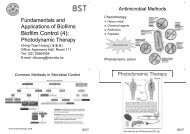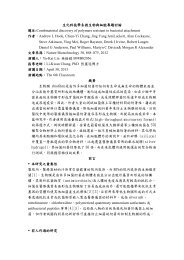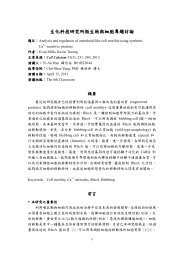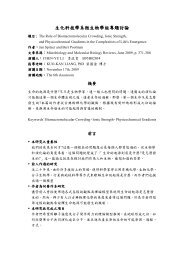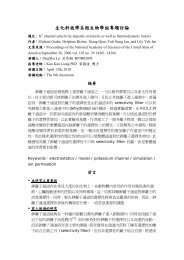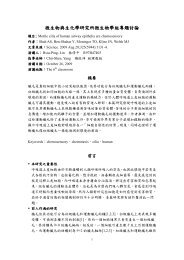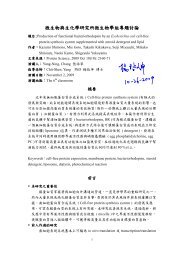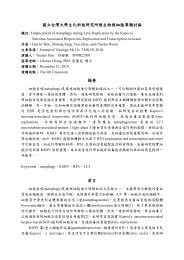Create successful ePaper yourself
Turn your PDF publications into a flip-book with our unique Google optimized e-Paper software.
生化科技研究所微生物與細胞專題討論<br />
題目: A new peptide motif present in the protective antigen of anthrax toxin exerts<br />
its efficiency on the cellular uptake of liposomes and applications for a<br />
dual-ligand system<br />
作者:Golam Kibria, Hiroto Hatakeyama, Hideyoshi Harashima<br />
文章來源:International Journal of Pharmaceutics 412 : 106–114, 2011<br />
演講人:Hsiu-Wei Lee <strong>李琇瑋</strong> R00B22019<br />
指導老師:Chin-Tin Chen, PhD 陳進庭 博士<br />
演講日期:December 12, 2011<br />
演講地點:The 6th Classroom<br />
摘要<br />
Protective antigen (PA) 是一個位於 anthrax toxin 上的無毒蛋白,其 domain 4<br />
(PA-D4)中的 KYND motif 是 tumor endothelial marker 8 (TEM8)此 receptor 的目標<br />
Ligand 。作者藉由 TEM8 positive 及 negative cells,來驗證 liposome 上有帶有 KYND<br />
motif,便可以增加細胞對 liposome uptake 的量。經由實驗證明,有 KYND motif<br />
的 liposome (KYND-PEG-LP) 被細胞 uptake 的量相較於沒有 motif 的 liposome<br />
(PEG-LP)被 uptake 的量有明顯增加趨勢,因此 KYND motif 功能就像是一種 cell<br />
penetrating peptide (CPP),能幫助 liposome 經由 clathrin mediated endocytosis<br />
pathway 的方式被細胞攝入。此外,當 KYND-PEG-LP 與 octaarginine (R8)一起呈現<br />
在 liposome 表面時,更可以加強細胞 uptake liposomes 的量;然而,若 liposomes<br />
只單一表現 R8,細胞對它們並沒有顯著的 uptake 量。本篇研究證明了當 liposome<br />
表面存在兩種 CPP ligands 時具有協同效應,可以促進細胞 uptake 藥物,因此<br />
dual-CPP ligand based 模式可能是一個能有效促進細胞 uptake 藥物的系統。<br />
Keywords:Anthrax toxin, Tumor endothelial marker 8, Liposomes, Cell penetrating<br />
peptide, Dual-ligand<br />
本研究之重要性<br />
前言<br />
Liposome 是一個在生物體應用相當廣的 nano-carriers,可以用來輸送藥物到 in<br />
vitro 的目標細胞或者 in vivo 內的病變組織[1][2]。將 KYND peptide 接在 PEG-LP<br />
的 PEG 上,可以讓 liposome 更容易地進入到細胞內。<br />
前人作過的研究<br />
Cell- penetration peptides (CPPs)是一個短的胺基酸序列,近來用在藥物以及基<br />
因的輸送上[3]。在包有 plasmid DNA、small interfering RNA、或 protein的 liposome<br />
表面修飾 stearylated octaarginine (STR-R8),使 liposome 可以有效的被細胞<br />
1
internalized[4][5][6]。<br />
作者為何要作本研究<br />
前人已證實在 liposome 表面修飾 STR-R8,可以增加 cell uptake 的量,但是效<br />
果並沒有很顯著,因此作者想要製作一種 dual-CPP ligand based 的 liposomes,<br />
實驗嘗試是否能夠顯著增加 liposomes 被 uptake 的量。<br />
本研究欲完成之項目<br />
製作出 dual-CPP ligand based 的 liposomes,比較 dual-CPP ligand based 的<br />
liposomes 與 single-CPP ligand based liposomes 分別被細胞攝取的量,欲了解具<br />
雙重 CPP 的 ligand 是否有 synergetic 效應。<br />
將 KYND peptide 接到 PEG-LP<br />
材料與方法<br />
將 KYND peptide 與 maleimide-PEG-DSPE 以 1:1 的比例加在去離子水中,並且在<br />
室溫反應 24 h,之後打 MS 確認 peptide 的合成情況。<br />
Liposomes 的製備<br />
Liposomes 由 EPC/Chol 以 molar ratio: 7/3 比例組成溶在有機溶劑中,隨後抽乾<br />
solvent 得到 lipid film。加入 HEPES buffer (10 mM, pH 7.4)水解 lipid film 10 分鐘<br />
後,將玻璃試管以超音波震盪 30 秒。在製作 film 的同時要加入 1 mol%<br />
rhodamine-DOPE 作為 lipid 成分的 label,此外為了測試 liposome 的性質,也要<br />
在 lipid 形成的 solution 中加入 STR-R8、 PEG-DSPE、 KYND-PEG-DSPE 這些 lipid。<br />
細胞培養<br />
用 Dulbecco’s modified Eagle’s medium (DMEM)加入 10% FBS、penicillin (100<br />
units/mL)、streptomycin ((100 μg/ml),培養 Human cervical carcinoma cells (HeLa)<br />
以及 mouse pancreas endothelial cells (MS-1),培養箱條件: 5% CO2 and 含 95%<br />
濕度及在 37℃◦<br />
評估 TEM8 的表現<br />
細胞用 PBS (pH 7.4) wash,並且用 trypsin-EDTA 將 cells detached 起來,接著用<br />
anti-TEM8 的 antibody 與細胞在 4 ℃下作用 20 分鐘。接著再以 Alexa Flour 488<br />
labeled secondary antibody 在 4 ℃下作用 20 分鐘。每個 sample 取約 1 萬個細<br />
胞用 FACSVantageSE flow cytometer (BD, San Jose, CA, USA)分析。<br />
細胞 uptake 的研究<br />
40,000 cells 種在 24-well plate,以 37 ℃、5 % CO2 及 95 %的濕度培養細胞至隔<br />
夜,24 h 後加入有 rhodamine labeled liposomes ,在 37 ℃、5 % CO2 及 95 %的<br />
濕度的條件下培養 3 小時。隨後以 1 mL 的含 heparin (20 units/ml)冰的 PBS 洗<br />
三次,接著加入 Reporter Lysis Buffer (Promega Corp., Madison, WI, USA) ,以<br />
12,000 rpm 在 4℃下離心 5 分鐘去除殘留物,最後以螢光分析偵測 rhodamine<br />
labeled 的 liposome 含量。<br />
2
有抑制劑存在下的 Inhibition assay<br />
分成有 free peptide 存在下的 inhibition assay,以及有修飾 KYND 於 PEG-LP 上<br />
面但沒有用 rhodamine 標定的 inhibition assay。<br />
(1) 有 Free peptide 存在下 :<br />
加入 25:1 的 KYND peptide 與 KYND-PEG-LP 在 Kreb’s buffer 中進行反應,在 37<br />
℃,5% CO2 and 95% humidity 中反應 1 h,一小時後加入 LPs 在培養 3 h。用 1 mL<br />
冷的 PBS 洗三次,再加入 heparin (20 units/ml)懸浮 liposomes,隨後以螢光偵<br />
測 rhodamine。<br />
(2) 存在 unlabled PEG-LPs :<br />
將 40,000 HUVECs 種在 24-well plate 置於 37 ℃, 5% CO2 和濕度 95%,Next day,<br />
將 10 mol % 有 rhodamine labeled 和 unlabeled PEG-LP 以不同濃度比(1:0, 1:5,<br />
1:10, 1:20 and 1:50) 加入,隨後培養 3 h。3 小時後,分別用 1 ml PBS wash 三<br />
次,加入 heparin (20 units/ml)將 KYND-PEG-LP 懸浮起來,偵測 rhodamine 螢光。<br />
(3) 有抑制劑存在下細胞攝入 KYND-PEG-LPs :<br />
40,000 Hela cells 種在 24-well plate 後在 37 ℃,5% CO2 以及 95%濕度中培養至<br />
隔夜。在 transfection 前,先用 1 mL PBS wash,在加入抑制劑前先用 Kreb’s buffer<br />
pre-incubated 數次後,分別加入 Amiloride (5 mM) 作用 30 分鐘;sucrose (1 M)<br />
作用 30 min 或 Filipin III (400 μg/ml) 作用 1 h,將溫度都控制在 37 ℃。將 KYND<br />
修飾的 PEG-LPs 加到上述的含抑制劑溶液中在 37 ℃培養 1 h,之後用冷的 PBS<br />
wash 細 胞 三 次 , 再 加 入 heparin (20 units/ml) 懸 浮 貼 在 dish 壁 上 的<br />
KYND-PEG-LP ,再用螢光測 rhodamine 的吸光值。<br />
統計分析<br />
Pair-wise comparisons 用 Student’s t-test,多組數據則用 one-way analysis of<br />
variance (ANOVA)分析,接著用 Dunnett test。至於多因子分析,使用 two-way<br />
ANOVA,若 P value < 0.05 視為顯著差異。<br />
結果與討論<br />
KYND peptide ligand 會影響細胞攝入 PEGylated LPs<br />
在 PEG-LPs 上修飾 KYND 會增進 HUVEC、TEM8 positive 細胞(有表現 TEM8<br />
receptor)的攝入率,而當 PEG-LPs 達 10 mol %的修飾時細胞會有最大吸收率。<br />
除此之外,在 MS-1 and Hela cells、TEM8 negative cells (沒有 TEM8 receptor),<br />
有 KYND 修飾也可以增進細胞攝入 KYND-PEG-LPs。<br />
評估有 KYND 修飾的 PEG-LPs 的被細胞攝入的途徑<br />
(1) Free peptide (KYND) 對細胞攝入 KYND-PEG-LPs 的抑制:<br />
將 KYND 修飾的 PEG-LPs 與 Free peptide 一起加在細胞中培養,3 小時後測吸<br />
光,Free peptide 對 KYND-PEG-LPs 被 uptake 的情形並沒有顯著影響,結果指<br />
出 KYND peptide 的功能並非作用於細胞膜上特定的 receptor 分子,而增加細<br />
胞 uptake 的量。<br />
3
(2) KYND-PEG-LP unlabeled rhodamine 對與 labeled rhodamine 對細胞攝入<br />
Liposomes 的影響:<br />
Labeled rhodamine 的 KYND-PEG-LPs 被細胞攝入的量,受到外加 unlabeled<br />
KYND-PEG-LPs 的影響很大,另以 R8 作為 targeting peptide 的模式中,也有類<br />
似的情形。如果加入 R8-PEG-LPs 與 KYND-PEG-LPs 競爭被 cell uptake 的量,造<br />
成 KYND-PEG-LPs 被 uptake 的量也有下降的趨勢。<br />
(3) 使用抑制劑找出細胞 uptake 的 pathway:<br />
加入 sucrose 作為抑制劑,明顯下降了 KYND-PEG-LPs 被 uptake 的量,然而<br />
amiloride 及 filipin 這兩種抑制劑卻沒有抑制 cell uptake KYND-PEG-LPs。根據此<br />
實驗指出,有 KYND 修飾的 PEG-LPs 被攝入細胞的途徑是經由 clathrin-mediated<br />
endocytosis pathway。<br />
(4) 細胞攝入 dual-ligand 的 PEG-LPs 的效率:<br />
有 R8 修飾的 PEG-LPs 對 cellular uptake 的影響只有些微增加,由於 R8 性質會<br />
受到 PEG layer steric hindrance 的影響,使之不易與細胞表面接觸。然而在<br />
dual-ligand 的 PEG-LPs 中,同時有 KYND 及 R8 這兩種 ligands,在所有 cell lines<br />
中都有增進細胞 uptake 的能力,uptake 的效果比 KYND-PEG-LPs 或 R8-PEG-LPs<br />
都還要好。<br />
參考文獻<br />
1. Puri, A., Loomis, K., Smith, B., Lee, J.H., Yavlovich, A., Heldman, E., Blumenthal,<br />
R.,2009. Lipid-based nanoparticles as pharmaceutical drug carriers: from<br />
concepts to clinic. Crit. Rev. Ther. Drug Carrier Syst. 26, 523–580.<br />
2. Du, S.L., Pan, H., Lu, W.Y., Wang, J., Wu, J., Wang, J.Y., 2007. Cyclic Arg-Gly-Asp<br />
peptide-labeled liposomes for targeting drug therapy of hepatic fibrosis in rats. J.<br />
Pharmacol. Exp. Ther. 322, 560–568.<br />
3. El-Sayed, A., Futaki, S., Harashima, H., 2009. Delivery of macromolecules using<br />
arginine-rich cell-penetrating peptides: ways to overcome endosoma entrapment.<br />
AAPS J. 11, 13–22.<br />
4. Khalil, I.A., Futaki, S., Niwa, M., Baba, Y., Kaji, N., Kamiya, H., Harashima, H., 2004.<br />
Mechanism of improved gene transfer by the N-terminal stearylation of<br />
octaarginine: enhanced cellular association by hydrophobic core formation. Gene<br />
Ther. 11, 636–644.<br />
5. Nakamura, Y., Kogure, K., Futaki, S., Harashima, H., 2007. Octaarginine-modified<br />
multifunctional envelope-type nano device for siRNA. J. Control Release 119,<br />
360-367.<br />
6. Suzuki, R., Yamada, Y., Harashima, H., 2007. Efficient cytoplasmic protein delivery<br />
by means of a multifunctional envelope-type nano device. Biol. Pharm. Bull. 30,<br />
758–762.<br />
4



